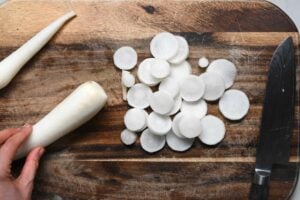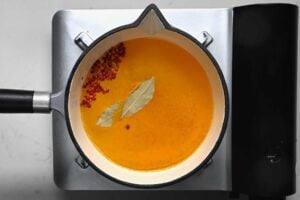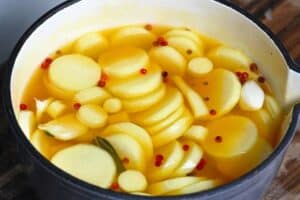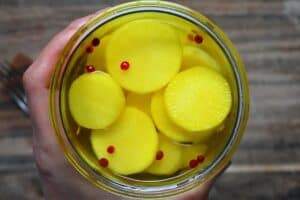This post may contain affiliate links. Please read our disclosure policy.
Learn how to make a quick and easy pickled daikon radish in 10 minutes and with a few simple ingredients. Pickled daikon is a delicious appetizer or side dish and can be added to rice bowls, sandwiches, and more!

Daikon (from Japanese, meaning “big root”) is a large, long, white radish that is similar to a giant white carrot and is the perfect veggie to pickle. When pickled with turmeric, it turns a vibrant yellow color and adds a tangy crunch and a delightful flavor twist to your dishes.
Plus, the process of making it is really quick and easy to do at home, with just a few minutes of hands-on time. So, let’s learn how to make this quick pickle daikon recipe.

Watch how to make it
Ingredients

- Daikon radish: You’ll find fresh daikon radish in the produce section in any Japanese market, Korean market, or large Asian grocery store. If you prefer, you can also use Korean radish – though it will be crunchier.
- For the pickle brine: I use rice vinegar (or apple cider vinegar), water, sugar, and pickling salt.
- For flavor: I’ve found the best spices to use in this recipe are peppercorns, ground turmeric, garlic, and bay leaves. You can adjust to your preference. You can also use homemade turmeric powder for the best color and flavor.
You also need a 27 oz/800ml jar with a lid.
See the printable recipe card below for full information on ingredients and quantities.
How to make pickled daikon
Prepare your Jar: Before you start, you need to sterilize your jar. Wash it well, then place it in the oven to dry completely at 325ºF/160ºC (about 10-15 minutes). Remove any plastic or rubber parts from it.
Prepare the Daikon: Clean the daikon radish well. You don’t have to peel them, but I like to. Then, slice into thin rounds. Alternatively, chop it into cubes, cut it into matchsticks, or make thin, long strips with a veggie peeler.

Make the Brine: Prepare the brine in a medium-sized saucepan. Add all the liquid ingredients and spices and boil on medium heat until the sugar dissolves – about 3 to 4 minutes. Stir occasionally.

Combine and Cool: Remove the brine from the heat and add the sliced daikon. Allow the mixture and the radish slices to cool to room temperature for about 30 minutes.

Jar the Pickles: Once the pickled radish is cool, pour everything into the sterilized jar. Make sure all of the slices are covered with the pickling liquid.

Refrigerate and Serve: Refrigerate the pickles overnight before serving—keep them in the fridge for at least 8 hours. The flavor will develop a more pungent pickled taste after 48 hours, and it becomes even more delicious the longer it sits. The pickled daikon will also turn bright yellow in color. They are best served cold.

FAQs
Daikon, a part of the radish family, is a white winter radish known for its abundance of leafy greens. Long and stout (like a large carrot), it’s classified as a cruciferous vegetable. Often referred to as Japanese radish, it originates from Japan and is commonly enjoyed pickled.
Crunchy and firm, daikon has a flavor profile similar to the more commonly known red radish but with a slightly sweeter taste. You can eat it raw, pickled, or cooked, and all parts of the daikon, including the greens and sprouts, are edible. You don’t even have to peel it!
Though similar in taste and appearance to daikon, Korean pickled radish is often shorter and rounder than its Japanese counterpart. It can also be slightly greener at the top than a daikon radish, which will be white all the way around.
Choose a daikon that’s firm and taut to the touch and quite heavy. Also, the best daikon has white and smooth skin with evenly spaced holes that are straight down the bottom.
Keep the pickled daikon in the jar with the brine and place it in the fridge. I recommend you consume them within a month, though they can last longer.
Pickled daikon radish is commonly served as a side dish with Korean meals, sushi, or as a palate cleanser with Japanese dishes. You can enjoy it alongside chicken ramen, Korean bibimbap, and more.
It’s also a popular addition to Vietnamese Banh Mi sandwiches, where it’s generously stuffed, as well as in noodle bowls or alongside meat dishes.
Its crisp texture and tangy flavor make it a versatile addition to salads, bowls, and many other dishes.
More pickled vegetables
- Quick Pickled Red Onions
- Crunchy Pickled Okra
- Easy Pickled Cucumbers
- Pickled Green Tomatoes
- How to Make Pickled Garlic
- Pink Pickled Turnips
- Quick Pickled Cabbage
- Quick Pickled Asparagus
Also, you might want to check these 12 popular types of radishes and what to do with radishes!
If you try this pickled daikon recipe, let me know how it goes in the comments below. I’d appreciate a recipe card rating and would love to see your recipe recreations – tag me on Instagram @Alphafoodie!

Pickled Daikon Radish
Equipment
- Mandoline or a sharp knife
- 1 Big glass jars 27 oz/800ml with a lid
Ingredients
- 1 pound daikon radish or use Korean radish
- 1 cup water
- 1 cup rice vinegar or white vinegar or apple cider vinegar
- 1/3 cup sugar
- 1 Tbsp pickling salt
- 1/2 Tbsp peppercorns
- 1 tsp ground turmeric
- 2 cloves garlic
- 2 bay leaves
Instructions
- To sterilize the jar, wash it well, then place it in the oven to dry completely at 325ºF/160ºC (about 10-15 minutes). Remove any plastic or rubber parts from it.
- Grab your daikon and clean it well. You don't have to peel it, but I like to. Then, slice it into thin rounds (see note below for more info).

- Add all the liquid ingredients and spices to a saucepan. Bring to a boil on medium heat until the sugar dissolves, about 3 to 4 minutes. Stir occasionally.

- Remove the brine from the heat and add the sliced daikon. Let it cool to room temperature for 30 minutes.

- Once cool, pour everything into the sterilized jar, making sure all of the slices are covered with the brine. Refrigerate the pickles overnight (at least 8 hours) before serving. The pickled daikon will have turned bright yellow.

Video
Notes
Nutrition
Nutrition information is automatically calculated, so should only be used as an approximation.














You are absolutely brilliant. I loved pickled Daikon in my sushi and poke bowls but realized the ingredients are pretty bad for you. I searched for a healthy version but no brand exists that’s healthy here in the US. I tried to pickle my own but the hubby made me toss it as they make the fridge stinky (worth it though). I’ve done quick pickling before for banh mi sandwiches and not sure why I didn’t think of doing Daikon this way. Genius!
Thanks for your sweet comment, Stacy! Quick pickling is definitely the way to go for Daikon. I hope you make it again and again! Happy cooking <3
What a great and easy No Nonsense recipe I’m so glad you posted this because in the Korean store that I go to the ingredients for kimbap has become smaller and yet more expensive so now I can make my own thank you so much
Hi Christine! I’m so glad you found the recipe helpful! Making your own kimbap sounds like a fun idea, especially since the ingredients can be pricey. Thanks so much for the feedback
I have made this recipe a couple of times now and it is delicious. I am wondering if you think it might work with turnips? Thanks!
Glad you liked it, Patrice.
Yes, the same method can work with turnips. There is a also a recipe for pink turnips here on the blog if you want to give that a try: https://www.alphafoodie.com/simple-pink-pickled-turnips/